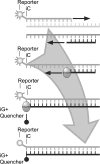Multiplexed detection of anthrax-related toxin genes
- PMID: 16436639
- PMCID: PMC1592686
- DOI: 10.2353/jmoldx.2006.050049
Multiplexed detection of anthrax-related toxin genes
Abstract
Simultaneous analysis of three targets in three colors on any real-time polymerase chain reaction (PCR) instrument would increase the flexibility of real-time PCR. For the detection of Bacillus strains that can cause inhalation anthrax-related illness, this ability would be valuable because two plasmids confer virulence, and internal positive controls are needed to monitor the testing in cases lacking target-specific signals. Using a real-time PCR platform called MultiCode-RTx, multiple assays were developed that specifically monitor the presence of Bacillus anthracis-specific virulence plasmid-associated genes. In particular for use on LightCycler-1, two triplex RTx systems demonstrated high sensitivity with limits of detection nearing single-copy levels for both plasmids. Specificity was established using a combination of Ct values and correct amplicon melting temperatures. All reactions were further verified by detection of an internal positive control. For these two triplex RTx assays, the analytical detection limit was one to nine plasmid copy equivalents, 100% analytical specificity with a 95% confidence interval (CI) of 9%, and 100% analytical sensitivity with a CI of 2%. Although further testing using clinical or environmental samples will be required to assess diagnostic sensitivity and specificity, the RTx platform achieves similar results to those of probe-based real-time systems.
Figures




Similar articles
-
Detection of Bacillus anthracis DNA by LightCycler PCR.J Clin Microbiol. 2002 Aug;40(8):2897-902. doi: 10.1128/JCM.40.8.2897-2902.2002. J Clin Microbiol. 2002. PMID: 12149348 Free PMC article.
-
Development and validation of a real-time quantitative PCR assay for rapid identification of Bacillus anthracis in environmental samples.Appl Microbiol Biotechnol. 2010 Nov;88(5):1179-92. doi: 10.1007/s00253-010-2848-0. Epub 2010 Sep 9. Appl Microbiol Biotechnol. 2010. PMID: 20827474
-
Polyphasic characterization of Bacillus species from anthrax outbreaks in animals from South Africa and Lesotho.J Infect Dev Ctries. 2016 Aug 31;10(8):814-23. doi: 10.3855/jidc.7798. J Infect Dev Ctries. 2016. PMID: 27580326
-
Advances in Anthrax Detection: Overview of Bioprobes and Biosensors.Appl Biochem Biotechnol. 2015 Jun;176(4):957-77. doi: 10.1007/s12010-015-1625-z. Epub 2015 May 19. Appl Biochem Biotechnol. 2015. PMID: 25987133 Review.
-
[Present status and prospects for the detection of Bacillus anthracis--a review].Wei Sheng Wu Xue Bao. 2012 Jul 4;52(7):809-15. Wei Sheng Wu Xue Bao. 2012. PMID: 23115964 Review. Chinese.
Cited by
-
Swab protocol for rapid laboratory diagnosis of cutaneous anthrax.J Clin Microbiol. 2012 Dec;50(12):3960-7. doi: 10.1128/JCM.02076-12. Epub 2012 Oct 3. J Clin Microbiol. 2012. PMID: 23035192 Free PMC article.
-
Implications of limits of detection of various methods for Bacillus anthracis in computing risks to human health.Appl Environ Microbiol. 2009 Oct;75(19):6331-9. doi: 10.1128/AEM.00288-09. Epub 2009 Jul 31. Appl Environ Microbiol. 2009. PMID: 19648357 Free PMC article.
-
Comprehensive DNA signature discovery and validation.PLoS Comput Biol. 2007 May;3(5):e98. doi: 10.1371/journal.pcbi.0030098. Epub 2007 Apr 20. PLoS Comput Biol. 2007. PMID: 17511514 Free PMC article.
-
Development and Evaluation of a Novel Taqman Real-Time PCR Assay for Rapid Detection of Mycoplasma bovis: Comparison of Assay Performance with a Conventional PCR Assay and Another Taqman Real-Time PCR Assay.Vet Sci. 2015 Mar 16;2(1):32-42. doi: 10.3390/vetsci2010032. Vet Sci. 2015. PMID: 29061929 Free PMC article.
-
Detection and quantification of hepatitis C virus (HCV) by MultiCode-RTx real-time PCR targeting the HCV 3' untranslated region.J Clin Microbiol. 2009 Aug;47(8):2635-8. doi: 10.1128/JCM.02170-08. Epub 2009 Jun 17. J Clin Microbiol. 2009. PMID: 19535519 Free PMC article.
References
-
- Logan NA, Carman JA, Melling J, Berkeley RC. Identification of Bacillus anthracis by API tests. J Med Microbiol. 1985;20:75–85. - PubMed
-
- Saiki RK, Scharf S, Faloona F, Mullis KB, Horn GT, Erlich HA, Arnheim N. Enzymatic amplification of beta-globin genomic sequences and restriction site analysis for diagnosis of sickle cell anemia. Science. 1985;230:1350–1354. - PubMed
-
- Hoffmaster AR, Ravel J, Rasko DA, Chapman GD, Chute MD, Marston CK, De BK, Sacchi CT, Fitzgerald C, Mayer LW, Maiden MC, Priest FG, Barker M, Jiang L, Cer RZ, Rilstone J, Peterson SN, Weyant RS, Galloway DR, Read TD, Popovic T, Fraser CM. Identification of anthrax toxin genes in a Bacillus cereus associated with an illness resembling inhalation anthrax. Proc Natl Acad Sci USA. 2004;101:8449–8454. - PMC - PubMed
-
- Beyer W, Glockner P, Otto J, Bohm R. A nested PCR method for the detection of Bacillus anthracis in environmental samples collected from former tannery sites. Microbiol Res. 1995;150:179–186. - PubMed
Publication types
MeSH terms
Substances
Grants and funding
LinkOut - more resources
Full Text Sources
Other Literature Sources

